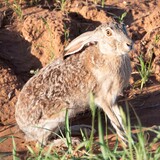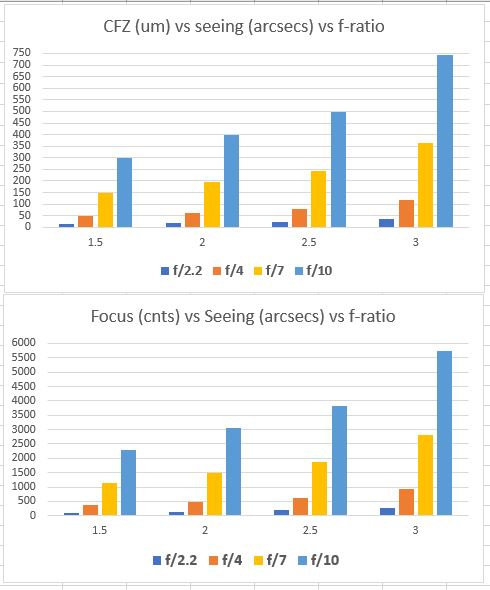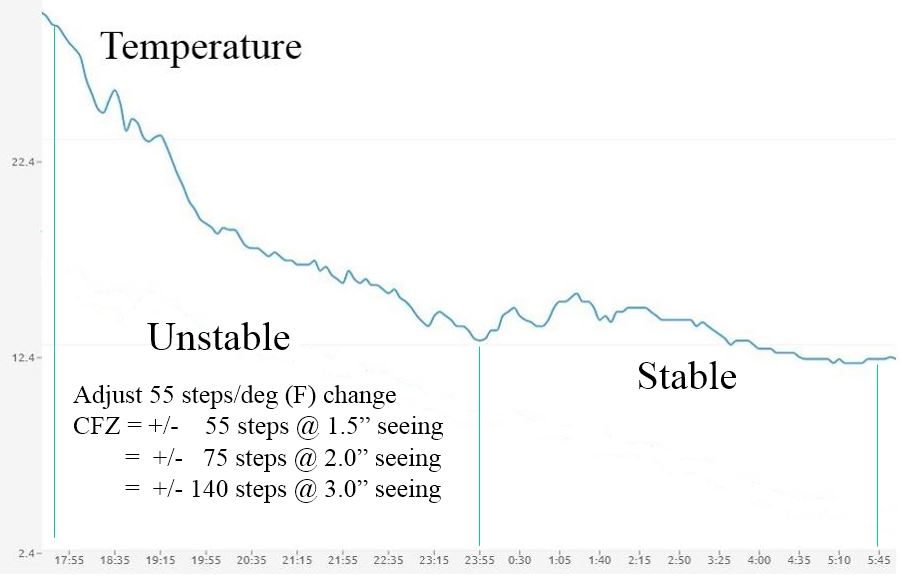INDI Library v2.0.7 is Released (01 Apr 2024)
Bi-monthly release with minor bug fixes and improvements
Temperature and Altitude (residual) focus compensation
- Brian Davis
-

- Offline
- Junior Member
-

- Posts: 33
- Thank you received: 15
Replied by Brian Davis on topic Temperature and Elevation focus compensation
It's not a position graph, it's a graph of the Index of refraction versus the elevation angle at standard temperature and pressure (STP). It is a number representing the angular displacement of incident light rays through the atmosphere showing the effect of thickness of the transited airmass between the observer and the celestial target. The calculated index is directly influenced by temperature and pressure (among other things, but these are the two largest factors), Elevation angle is a scalar value, and it's change due to earth rotation, is based on the location data, which doesn't change (or shouldn't)., so it has no mathematical relationship to temperature, and isn't a proxy value for anything. Unless your mount is on a moving object, it will not have have a direct impact of tracking error, unless .
Temperature has several effects. It causes the materials in the mount or gear to expand or contract, which can change the elevation angle slightly, and the error it produces will be relatively constant, and always in the same direction relative to the direction of the temperature change. So you wouldn't expect to see a lot of tracking error scattered about the regression line, instead you'd see the directrix of the parabolic regression line move up or down the Y axis, but the parabola itself doesn't change its shape.
The principle effect of temperature changes is that they change the index of refraction (RI), and thus change the apparent size of celestial objects. If the atmosphere were still and well regulated, then this wouldn't be a problem, but it isn't. It roils, changes density, and the stratification of the air changes, and this produces inherent error in the RI, and that translates directly to focusing, tracking and guiding errors, and those will be randomly scattered about the calculated RI.
In your post, you refer to Temperature Compensation as though it is a single term, but it's not. It's an ephemeral value calculated specifically for each value modified. There is no one "Temperature Compensation" value. Theres one for refraction, one for expansion/contraction, and probably others. A programmer would have to discuss how they used temperature in the various processes, to discuss it in more specific terms, but the main takeaway, is that temperature compensation is only a meaningful term when it includes the process or value being compensated. It will be different for every process.
It's not. The elevation is fixed (or should be) and does not change during a session. It is used for the initial calculation of the RI (and alignment, etc), but thereafter is constant, and so has no further effect on focusing or focus error. RI, on the other hand, continuously changes, and has a direct and pronounced effect of focus error.
Please Log in or Create an account to join the conversation.
Replied by Bart on topic Temperature and Elevation focus compensation
Also, if you take refraction into account, will you then -not- take it into account when using narrow band filters? There the effect isn't measurable.
Now a question, would you consider to focus during imaging or quickly adjust the focus in between lights?
Personally, I don't use very long exposure lights, especially with Starlink up and screwing up our images.
Please Log in or Create an account to join the conversation.
- Brian Davis
-

- Offline
- Junior Member
-

- Posts: 33
- Thank you received: 15
Replied by Brian Davis on topic Temperature and Elevation focus compensation
Elevation usually refers to the geographic distance from the earths center, most often expressed as altitude above sea level. What you're referring to is most often called the zenith angle, or the angular displacement from zenith.
The Refractive Index applies to all electromagnetic radiation. It is usually calculated for yellow light for use in astronomy. However, the actual energy (frequeny and amplitude) of a received photon is an independent variable in the calculation for angular deflection produced by the refraction index.
I refocus on every 2 degree change in temperature, or guider crapout, or at the start of any sequence. Focus while taking lights isn't critical to the process, but shouldn't be changed between exposures.
Please Log in or Create an account to join the conversation.
Replied by Doug S on topic Temperature and Elevation focus compensation
My original post is simple: Two readily available variables in Ekos (temperature, (target) elevation=altitude) can be used to dramatically improve focus control. I've shown a relationship of temperature to focus. I've also shown that once factored, residuals of a temperature function can be correlated to target elevation. The data speak for themselves. Anyone who wishes can verify or refute the suggested relations by characterizing their own focus behavior via the focuser debug log. I am not stating that these two functions are the perfect and complete academic explanation. Rather, these two variables are readily available in Ekos, and serve particularly well to prevent poor auto-focus starting position, offset focus position between exposures, or prevent poor focus position after slews of large elevation difference. We're trying to remain close to the focus caustic. KISS can work well here. Cheers, Doug
Please Log in or Create an account to join the conversation.
Replied by Doug S on topic Temperature and Elevation focus compensation
Well, the data for my fast (f/2.2 setup) indicate that I "could" change the focus by 55 counts per degree F change, and ~21 counts per degree elevation change. It's tempting to think about an experiment with this and do a build where an auto update is done between exposures (but never during an exposure). I also do short (30-40 second) subs, so an autoupdate might keep me from having to do an autofocus run (expensive!) so often at the start of the night. Whether I'd trust it for a big elevation difference slew is debatable without a clipped higher order polynomial (to fit the low el data better), but it would be an interesting test. Eventually, and assuming a stable focuser with well controlled backlash, it might be quite effective at minimizing the need for autofocus runs. Right now, if I want to image for two hours on a target at the start of the night, I NEED to run autofocus every 20-40 exposures (or use the deltaT function). Would be nice to avoid that hassle....
Please Log in or Create an account to join the conversation.
- Brian Davis
-

- Offline
- Junior Member
-

- Posts: 33
- Thank you received: 15
Replied by Brian Davis on topic Temperature and Elevation focus compensation
Thus, estimating a step position based on that graphic, is statistically more likely to produce an out-of-focus image, than one in focus.
Please Log in or Create an account to join the conversation.
- Brian Davis
-

- Offline
- Junior Member
-

- Posts: 33
- Thank you received: 15
Replied by Brian Davis on topic Temperature and Elevation focus compensation
Please Log in or Create an account to join the conversation.
Replied by Doug S on topic Temperature and Elevation focus compensation
The temperature component works because the dominant error we're beating down is structural (shift of optics due to changing temp of the OTA). The next component (residual of the temp function) has complex / multiple underlying reasons, but airmass (target el) empirically correlates with the residual to help beat it down. Together, these two available variables get us within the ball park to improve focus management. The key to why this simplicity works is that we're NOT doing a one-time blind position update. We're not replacing the closed loop autofocus routine. We're only "seeding" the autofocus loop's start position. The autofocus loop is still responsible for resolving best focus position. Therefore, all the discussion about spread and CFZ size is misdirected. Ok, now to the next suggested higher automation level (updates between exposures). In that scenario, any position update would use the function outputs as integration OFFSETS from the base position determined by prior autofocus. Those offsets are small and driven by trendline direction. Here, the spread isn't as important as having the trend SWAMP the spread uncertainty so the direction and magnitude keep us within the CFZ and REDUCE our need for another autofocus run. I mentioned to Bart that I'm not sure I would trust a blind update for a large elevation difference slew (and I still believe that). Bottom line: The work needed to do a one-time blind offset and ELIMINATE autofocus runs is well beyond the scope of this thread. So, whether or not I've convinced you, I hear you. I suggest if you want to discuss a "predictive focus tool" that eliminates the autofocus loop, please open a new thread for that topic. I'd like to keep this thread within the bounds of improving and reducing the existing autofocus loop interface (as opposed to eliminating it). Cheers, Doug
Please Log in or Create an account to join the conversation.
Replied by Doug S on topic Temperature and Elevation focus compensation
FYI (in case it wasn't obvious): if you have low elevation targets at the beginning of the night to image, it pays to image these EAST if possible! Needed adjustments for falling temperatures partially negate needed adjustments for rising elevation. On the WEST side, these factors are additive AGAINST you, possibly preventing good hold on focus. Something to think about in your planning until we have compensation in place!
Finally, a few requests. I need some 3.5.x focus log data for f/4 through f/8 systems. If someone can send me a debug focus log snippet (see OP) or better...trendline data, it would be helpful for sensitivity analysis. If you might be interested in discussions of the GUI requirements/design for this project, I am toying with the idea of hosting a Zoom call before implementation goes too far. If interested, send me a separate note. Finally, I am still looking to partner with a GUI developer. This isn't my primary skill set, so I could use some help. Hopefully someone who is in the f/2 to f/7 camp will see their own need and want to partner! We can get this done.....Cheers and thanks. Doug
Please Log in or Create an account to join the conversation.
Replied by Doug S on topic Temperature and Elevation focus compensation
This month, I used a stand-alone program to manage an autofocus "integrator", and manually offset focus between exposures as temperature and elevation changed. Manually intensive, but the results were very satisfactory! There appears to be no Ekos "gotchas" for updating focus between exposures. Adjustment can coexistent with download, dither, or exposure delay timing. I was easily able to maintain focus in my f/2.2 rig as temperatures rapidly changed. One good seeded autofocus and then occasional updates between exposures will keep focus well managed. Only 1 autofocus needed per target!
So a couple of thoughts. My 7 night January run had some bad seeing in it. Autofocus has difficulty when HFR readings are bouncing all over the place. This adds to spread in the logged data. Linear autofocus tends to pull up short of the bottom of the V curve in bad seeing, especially if the last HFR reading (averaged or not) is marginally higher than the prior HFR reading. Getting one good autofocus result (even if manually adjusted), followed by AFC updates, seems like a better approach to managing focus than risking N funky autofocus results. Finally, while I started this idea thinking that a seeded autofocus was the goal, it now seems clear that AFC between exposures IS the goal. A seeded autofocus start is desirable, but realized AFC between exposures is a "can't live without" feature for f/2 & f/3 systems! So work will continue.... cheers, Doug
Please Log in or Create an account to join the conversation.
- Peter Sütterlin
-

- Offline
- Supernova Explorer
-

- Posts: 1009
- Thank you received: 133
Replied by Peter Sütterlin on topic Temperature and Elevation focus compensation
One thing that keeps me from 'blindly' adjusting focus based on temperature is focuser backlash. How do you handle this, especially how did you measure it (assuming you do have some)? One of the reasons I do like Hys focus routine that is insensitive to (at least small) BL.
An EKOS module to automatically compute focus backlash would be a nice thing
Please Log in or Create an account to join the conversation.
Replied by Doug S on topic Temperature and Elevation focus compensation
Honestly, I'm much less worried about BL than I am with position errors introduced when linear autofocus pulls up short. That kind of error needs to be addressed. Beyond the obvious logged position error, introducing AFC would have the effect of "freezing" that bad focus (relative position offset), resulting in AFC being less ideal than if multiple sloppy AF runs were done (assuming that some of those AF solutions would be good). I need to talk to Hy offline about what these charts suggest regarding sufficient precision of linear AF solutions, and how that might lead to some improvements. More later.... Cheers, Doug
Edit: One important thing to remember about AFC is that it's operating a trendline. Generally speaking, the temperature trend will be downward (bumps excepted). This means that BL isn't a factor because the adjustments are all unidirectional. If you were really worried about BL, you could avoid adjustments during reverse bumps (they typically don't last long). Guess: the magnitude of the BL probably needs to be less than 1/2 of the CFZ to be safely ignored otherwise.
Please Log in or Create an account to join the conversation.


